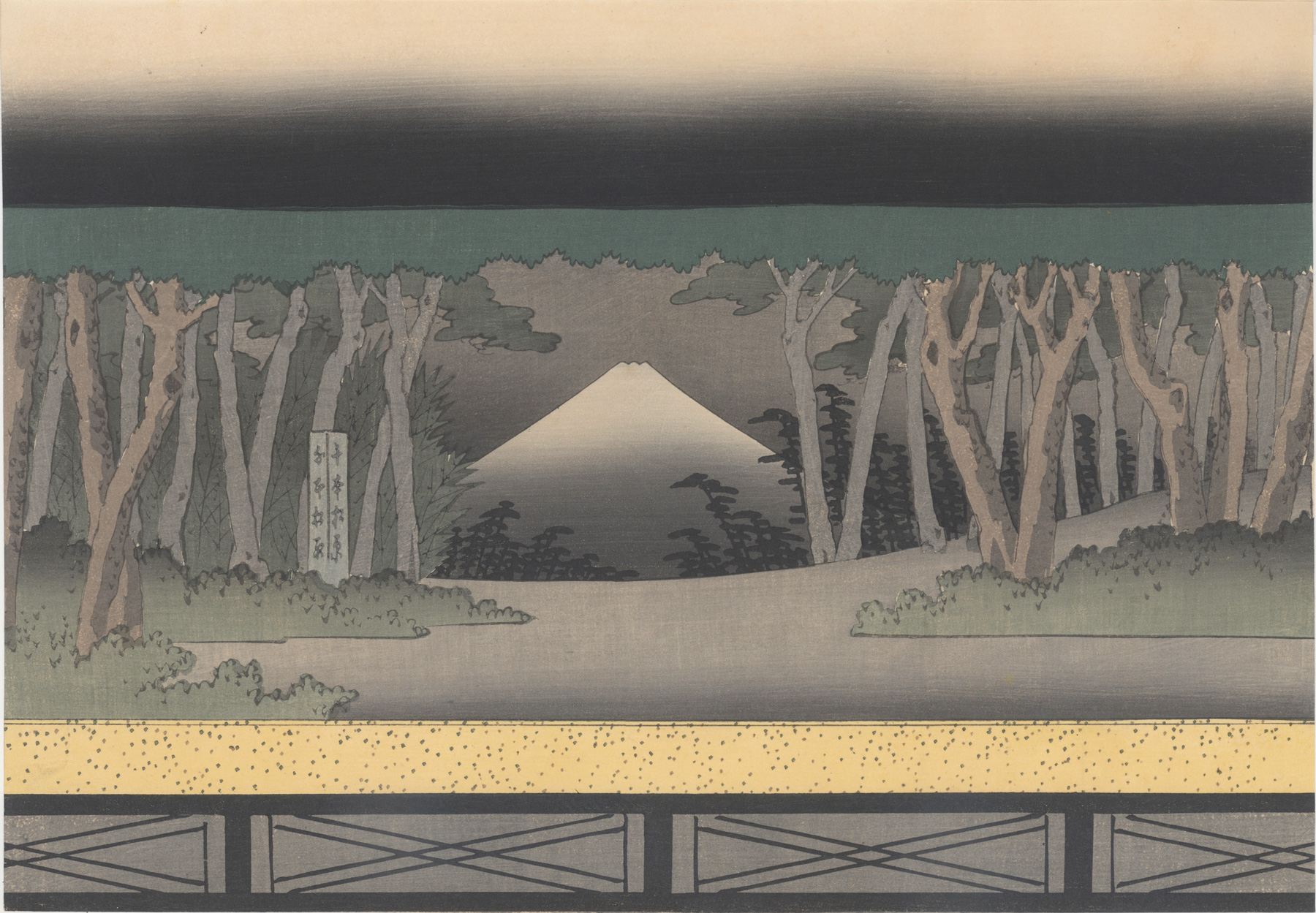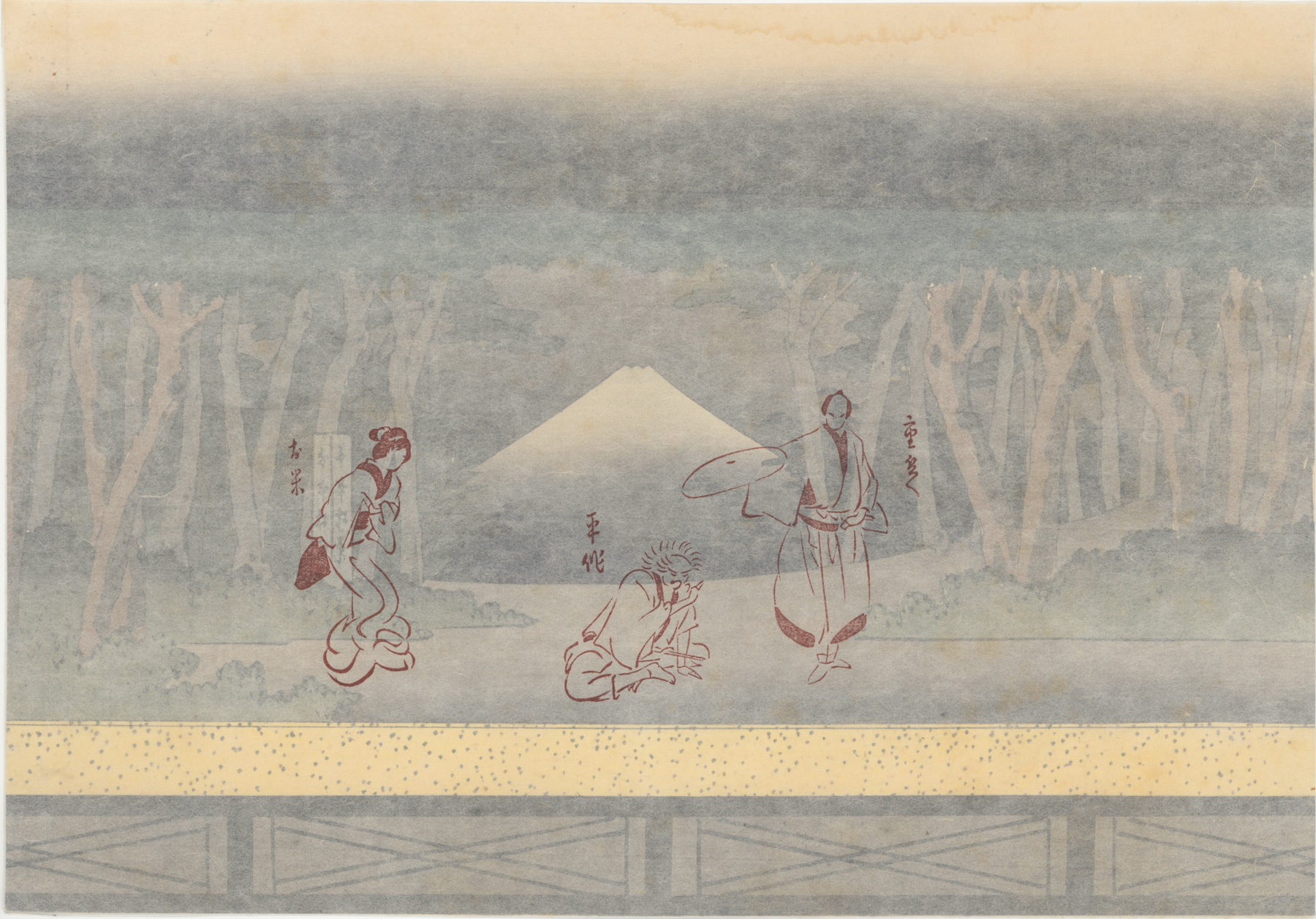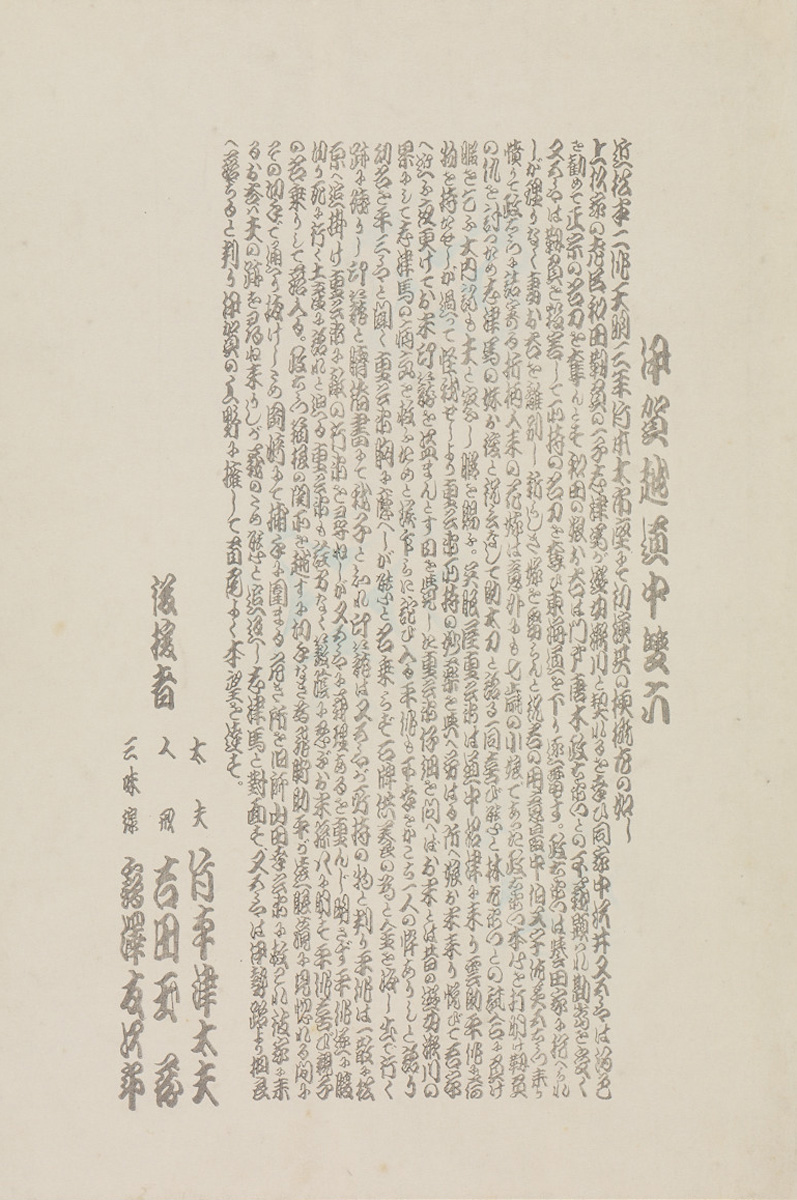About This Print
An illustration of the stage set for the play Igagoe dōchū sugoroku [Vendetta at Iga] written by Chikamatsu Hanji (1725-1783) and his collaborator Chikamatsu Kasaku and first staged in the puppet theater in 1783. The setting is at night along the Tōkaidō with Mount Fuji watching over.As originally issued, this print is complete with its tissue overlay showing the outlines of three puppet characters as they appear on stage.
Brief Plot Summary
The full ten-act puppet play was the final work of Chikamatsu Hanji, the last of the great puppet playwrights. It is based on one of Japan’s three great vendettas, the Revenge at Iga Ueno (or Duel at Kagiya Tsuji) of 1634. The story tracks the Tokaido Highway, as in the popular board game of “sugoroku”, from Kamakura to the vendetta spot in Kyoto’s Fushimi district. The play was a reworking of the Kabuki piece Igagoe Norikake Kappa of 1776. It describes the events in the Uesugi family when a famed sword instructor Wada Yukie is killed by his colleague Sawai Matagoro in a dispute over a treasured sword. Yukie’s son and son-in-law finally manage to kill the enemy after bringing death and difficulties to many others. The main story tells of the struggles to achieve the vendetta at the expense of the compassion for spouse, child and sibling. “Numazu” is a side story.
The three characters pictured on the tissue overlay are:
Heisaku - An old man working as a porter on the Tokaido Highway from Edo to Kyoto. He is honest, forthright and lovable, but also has the strength of will to give up his life for information on the enemy.
Jubei - A kimono merchant in Kamakura. In a chance encounter, he realizes that the old porter Heisaku is not only his own father, who gave him up for adoption as a child, but a member of the enemy side of a vendetta. This puts him in a bind between duty to his mentor and compassion for his father.
Oyone - Heisaku’s daughter. She was once a famous Edo courtesan named Segawa. She fell in love with Shizuma, who bought out her contract and married her. She endures a poor life and seeks the enemy’s whereabouts in order to help her husband achieve his vendetta.
Bunraku Stage Set

Stage Set for Ehon Taikoki (Records of the Taiko)
image source: website of Japan Arts Council Invitation to Bunraku
Source: Bunraku: The Art of the Japanese Puppet Theatre, Donald Keene and Hiroshi Kaneko, Kodansha International, Ltd., 1965, p. 22.
For those unfamiliar with the stage set for bunraku the following passages from Donald Keene's Bunraku: The Art of the Japanese Puppet Theatre are instructive:
"Soon after the chanter enters his description of the new scene, the curtain is drawn aside to reveal the set, a naturalistic rendering of a landscape or interior. If the backdrop represents an outdoor scene, it is painted on a series of vertical panels which may be moved laterally to suggest that characters (who remain in one place) are traveling. If an interior, the gate, framework of the house, and generally one room are depicted, with the suggestion of other rooms beyond. A garden or nearby building may also be represented. A doorway at the rear-center of the stage is usual, for it permits the female characters to make spectacular exits, displaying their figures from behind. Very few props are used; unless necessary to the action, the furnishings are generally painted on the backdrop, to allow the operators the maximum freedom of movement.
The Bunraku stage, traditionally 36 feet wide, 25 feet deep, and 15 feet high, is divided into various playing areas. The main stage occupies about half the total area, and often serves as the interior of a house. Three raised partitions of different heights run across the width of the stage, standing before the trench-like passages in which the operators work. The partitions conceal the lower half of the principal operator's body, more of the operator of the left hand (who does not wear high-platformed clogs), and almost all of the operator of the feet; at the same time, they provide the apparent floor or ground level on which the puppets walk or sit. To the audience's right is a dais projecting into the auditorium from the stage. There the chanter perches on bulky cushions before an elaborately fashioned reading-stand; to his left, the samisen player sits on a single cushion, dwarfed by the chanter."
The Other Prints in the Sugawara Denju Tenarai Kagami Set
As further explained below, each stage set print was part of a set of five prints consisting of a black and white explanatory sheet and three portraits of puppet characters appearing in the play.
伊賀越道中双六 Igagoe dōchū sugoroku
Source: Waseda University Cultural Resource Database 201-1518
 The four print set for Igagoe dōchū sugorokupuppets from left to right (as positioned on the stage set print's tissue overlay):Musume Oyone 娘お米, Oya Heisaku 雲助平作, Gofukuya Jūbei 呉服屋十兵衛
The four print set for Igagoe dōchū sugorokupuppets from left to right (as positioned on the stage set print's tissue overlay):Musume Oyone 娘お米, Oya Heisaku 雲助平作, Gofukuya Jūbei 呉服屋十兵衛

About the "Illustrated Collection of Famous Japanese Puppets of the Osaka Bunrakuza"
This collection of forty-eight color woodblock prints was designed by Hasegawa Sadanobu III (Konobu III) (1881-1963) and issued over the period March 1926 (Taishō 15) to August 1927 (Shōwa 2)1 by the publishing houses Bijutsusha 美術社 in Tokyo and on a subscription (members only) basis by Hangakai hanmoto 版画会板元 (板畫會板元) in Kyoto. The cost per print set was 3 yen. The editor and publisher for both the Bijutsusha and Hangakai hanmoto sets was Hayashi Eikichi 林榮吉, who was also the editor for Hasegawa's Collection of One Hundred Kumadori Makeups in Kabuki. (See Hasegawa Sadanobu III (Konobu III) (1881-1963) for prints from this collection.)
The Illustrated Collection of Famous Japanese Puppets of the Osaka Bunrakuza consists of twelve sets of prints each set depicting a specific play in the bunraku repertory, as listed in the below table. Each set contains a stage set for the specific play along with three prints of puppet characters appearing in the play and an explanatory sheet, for a total of forty-eight color woodblock prints and twelve monochrome explanatory sheets. Each of the stage set prints was originally issued with a tissue overlay showing the position of the three puppet characters on the stage. All of the plays pictured were performed at the Bunraku Theater (Bunraku-za) located within the Goryō Shrine compound in Osaka. The Goryō Bunraku-za burned down in November 1926 after what has been described as "an extremely difficult managerial era" and "lost interest" by the public in the late Taishō era.2 It is unknown what role, if any, the management of the Goryō Bunraku-za may have played in the formulation and issuance of this print series in their efforts to revitalize the theater.
For more complete information on this series see the article Illustrated Collection of Famous Japanese Puppets of the Osaka Bunrakuza
1 Dates are taken from the colophons on the envelopes containing the print sets in the Waseda University Archives2 National Diet Library website page http://www.ndl.go.jp/scenery/e/column/kansai/goryo_bunrakuza.html which provides a history of the Goryō Bunrakuza.
Play Name in Japanese Play Name in English 壇浦兜軍記
Dan-no-ura kabuto gunki Chronicle of the Battle of Dan-no-ura 義経千本桜
Yoshitsune senbon zakura Yoshitsune and the Thousand Cherry Trees 一の谷嫩軍記
Ichi-no-tani futaba gunki Chronicle of the Battle of Ichinotani 仮名手本忠臣蔵、五段目
Kanadehon Chūshingura, go danme The Treasury of Loyal Retainers, Act 5 仮名手本忠臣蔵、七段目
Kanadehon Chūshingura, shichi danme The Treasury of Loyal Retainers, Act 7 伊賀越道中双六
Igagoe dōchū sugoroku The Revenge at Igagoe 心中天網嶋
Shinjū ten no amajima The Love Suicides at Amijima 新版歌祭文
Shinpan Utazaimon The New Scandalous Ballad of Osome and Hisamatsu 菅原伝授手習鑑
Sugawara Denju Tenarai Kagami Sugawara and the Secrets of Calligraphy 本朝廿四孝
Honchō nijūshikō Twenty-four Examples of Filial Piety 鎌倉三代記
Kamakura sandaiki Three Generations of Kamakura Shoguns 夏祭浪花鑑
Natsumatsuri Naniwa kagami Summer festival at Naniwa (Osaka)
| Play Name in Japanese | Play Name in English |
| 壇浦兜軍記 Dan-no-ura kabuto gunki | Chronicle of the Battle of Dan-no-ura |
| 義経千本桜 Yoshitsune senbon zakura | Yoshitsune and the Thousand Cherry Trees |
| 一の谷嫩軍記 Ichi-no-tani futaba gunki | Chronicle of the Battle of Ichinotani |
| 仮名手本忠臣蔵、五段目 Kanadehon Chūshingura, go danme | The Treasury of Loyal Retainers, Act 5 |
| 仮名手本忠臣蔵、七段目 Kanadehon Chūshingura, shichi danme | The Treasury of Loyal Retainers, Act 7 |
| 伊賀越道中双六 Igagoe dōchū sugoroku | The Revenge at Igagoe |
| 心中天網嶋 Shinjū ten no amajima | The Love Suicides at Amijima |
| 新版歌祭文 Shinpan Utazaimon | The New Scandalous Ballad of Osome and Hisamatsu |
| 菅原伝授手習鑑 Sugawara Denju Tenarai Kagami | Sugawara and the Secrets of Calligraphy |
| 本朝廿四孝 Honchō nijūshikō | Twenty-four Examples of Filial Piety |
| 鎌倉三代記 Kamakura sandaiki | Three Generations of Kamakura Shoguns |
| 夏祭浪花鑑 Natsumatsuri Naniwa kagami | Summer festival at Naniwa (Osaka) |
Print Details
| IHL Catalog | #2475 |
| Title or Description | Bunraku Theater Stage Set for Igagoe dōchū sugoroku [Vendetta at Iga] Bunraku ningyō butaizu Igagoe dōchū sugoroku 文楽人形、舞台図、伊賀越道中双六 Note: also seen translated as Through Iga Pass wit the Tōkaidō Board Game; Play a Board Game of the Road to Iga Pass |
| Series | Illustrated Collection of the Famous Japanese Puppets of the Osaka Bunrakuza Ōsaka Bunraku-za Ningyō Gashū: Nihon Meibutsu 日本名物大阪文楽座人形画集 |
| Artist | Hasegawa Sadanobu III (Konobu III) (1881-1963) |
| Signature | not signed |
| Seal | not sealed |
| Publication Date | Taishō 15 (September 20, 1926) |
| Publisher | 美術社 Bijutsusha, Tokyo and 版画会板元 Hangakai hanmoto, Kyoto |
| Carver | 佐藤重一 Satō Jūichi |
| Printer | 板垣八重松 Itagaki Yaematsu |
| Impression | excellent |
| Colors | excellent |
| Condition | excellent |
| Genre | puppet theater stage set picture 文楽人形、舞台図 bunraku ningyō, butaizu |
| Miscellaneous | part of envelope (volume) 6 |
| Format | |
| H x W Paper | 9 7/8 x 14 3/16 in. (25.1 x 36 cm) |
| H x W Image | 9 7/8 x 14 3/16 in. (25.1 x 36 cm) |
| Literature | |
| Collections This Print | Waseda University Cultural Resource Database 201-1490; Ritsumeikan University Art Research Center AcNo. arcBK06-002_30; National Diet Library Call Number 414.38; The Met Thomas J. Watson Library 240.3081 H27 Quarto; British Library System number: 018894603 |
5/13/2021 created




